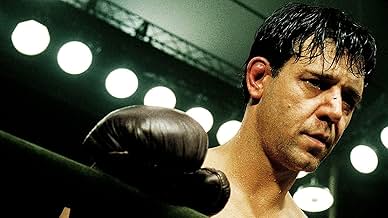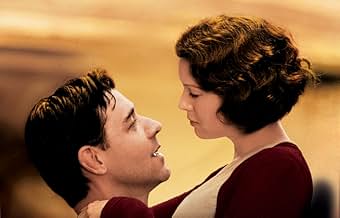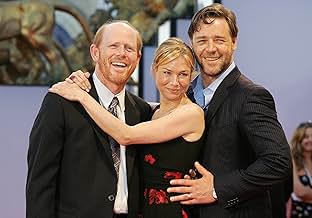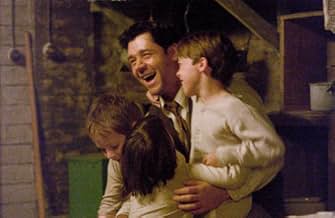Die Geschichte von James Braddock, einem angeblich angeschwemmten Boxer, der in den 1930er Jahren zurückkehrte, um Champion und Inspiration zu werden.Die Geschichte von James Braddock, einem angeblich angeschwemmten Boxer, der in den 1930er Jahren zurückkehrte, um Champion und Inspiration zu werden.Die Geschichte von James Braddock, einem angeblich angeschwemmten Boxer, der in den 1930er Jahren zurückkehrte, um Champion und Inspiration zu werden.
- Für 3 Oscars nominiert
- 16 Gewinne & 45 Nominierungen insgesamt
Empfohlene Bewertungen
The story of a family in the midst of the Great Depression was as compelling as the boxing story. The solid family man played by Russell gives us a much needed role model. The historical and socio-economic background was powerfully shown and greatly added to the audience's involvement and is particularly relevant to today. This is a classic film.
Oh, I forgot to mention one thing. This movie is about the best 140 minute I've spent in a movie theater since . . . . since . . . ., Oh, well, you get the picture. Better yet, instead of getting the picture, go see it.
Russell Crowe owns the character of James Braddock, the unlikely hero who makes the most of his second chance. He's a good fighter turned hack. Injury, bad luck and this thing called the Depression sends him down the drain.
His wife, Mae, played by Renee Zelleweger, wants to be his biggest fan, but the kids need a dad, the rent has to get paid and the money from boxing dried up along time ago. Her husband's courage is undoubted, but his nerve is killing her.
And then there's Joe Gould, played by Paul Giamatti.
A boxer by the name of George Cochan once told me his manager was the bravest man he ever knew, he was willing to pit his man (Cochan) against anyone. As a result, Cochan had his head handed to him multiple times by the likes of Jake LaMotta and other class middle weights of the Forties and Fifties. Gould, is that brave manager, if not literally, in spirit. He pits Braddock, out of shape and with one day notice, against the number two heavy weight contender. Regardless of the risk, it's a pay day needed by both Gould and Braddock.
The story, while familiar, is executed brilliantly. The camera work is both subtle and, in turn, spectacular. Craig Bierko, Paddy Considine, Bruce McGill and the rest of the cast give flawless performances.
Yes, been there, done that! And I'm ready to do it again for anyone who wants to go with me.
But this one has Russell Crowe in it. And that makes all the difference.
It is not that Renee Zellwegger and Paul Giamatti, Paddy Considine, Bruce McGill and Craig Bierko, among others, give less than stellar performances: they all live up to their justifiably great reputations. You have to believe they are at the top of their game. But for all of Russell Crowe's reputation for being "difficult", it is hard to think of actors who can equal his personal force on the screen. He is brilliant.
Ron Howard has made of the real life of Depression-era prize-fighter James J. Braddock a work of art. The camera work is phenomenal. Without using violins or cliché' pull-back shots showing the numbers of people homeless and in soup lines, Howard makes the Depression a visceral reality with scenes of near-hopeless men at the docks, pleading for a day's work; a stolen salami; Crowe's giving his daughter his breakfast piece of bologna, telling her he dreamed he was full. The bleakness of the times is the graininess and the sepia/greyness of the camera shots; the images are stark but completely descriptive. Crowe as Braddock with hat in hand and tears in his eyes, begging for twenty dollars so he can get his children back into his home, is the personification of pride sacrificed to desperation. But when Braddock is later asked at a press conference why he is fighting at his age and after so many poor showings, all he has to say is "milk" to be supremely eloquent.
Doubtless many people know the history of James Braddock, and know the outcome of his fights, including the championship bout with Max Baer, who had already killed two men in the ring. If you don't know, DON'T look it up before you see the movie, and if you DO KNOW, DON'T TELL, but go. Analogous to watching Howard's film "Apollo 13", you may know the outcome, but there's wonderful suspense in the details. These were among the most exciting last twenty minutes I've seen on film. I didn't expect to be able to watch, but like Braddock's terrified wife Mae, I was unable to tear myself away.
The audience was like a prize fight audience, cheering, booing, gasping, groaning during the fights. We applauded Braddock's wins, suffered his defeats. It is a great movie, with authentic heart. Solid A.
These films share in common not just a documentary-like approach to boxing or a superficial biopic. They also portray the human side of a modern gladiator and the culture that produced him. In the case of "Cinderella Man," we are given a detailed and heart-rending portrait of the Great Depression in American. The story of the gentleman pugilist James J. Braddock is the backdrop to the larger drama of Americans' struggle in the 1930s.
Russell Crowe provides a brilliant interpretation of Braddock, capturing the decency of a man whose career as a boxer would appear to have peaked at just the wrong time prior to the Crash of 1929. After that momentous event, Braddock's boxing went into decline just like the lives of millions of Americans. The scenes of Braddock and his family living in squalid conditions and with uncertainty about such basics as heat and electricity were carefully developed in the film. Renée Zellweger was outstanding as Mae, the caring but feisty wife of Braddock. Paul Giamatti was also excellent as Braddock's handler-manager, Joe Gould. Joe tries to keep up appearances by sporting fancy clothes. But in one revealing scene in the film when we see the interior of Joe's ostensibly swanky apartment, there is no fancy furniture other than a dowdy table and some flimsy deck chairs. Everyone is reeling from the Depression. In the depiction of the massive unemployment, the "Hoovervilles" of the homeless residing in Central Park, and the desperate need for Americans for an optimistic icon like Braddock to raise their spirits, the film truly captured the tragedy of the Great American Depression.
The film's director Ron Howard emphasized close-ups throughout the film with uneven results. In many of the boxing sequences, the close-ups and rapid editing made it difficult tell the fighters apart. The close-ups continued even into the domestic scenes and the outdoor sequences depicting Braddock working as a longshoreman. The film's dark cinematography conveyed the bleakness of the Depression years, but it worked against bringing out the buoyant spirit of Braddock himself and the optimism that he instilled in others. As a director, Howard's strength is not in film artistry or technique. As apparent in this and other films, his gift lies in narrative storytelling and the development of dramatic character.
Indeed, the characters and the story were the strong points of "Cinderella Man." Much credit should go to Cliff Hollingsworth for a screenplay that included thoughtful dialogue, humor, and multi-dimensional characters. Daniel Orlandi also merits praise for the brilliant costumes that helped to recreate the period of the early 1930s.
But the heart of this film experience is Russell Crowe's screen portrayal of Braddock. It was the colorful sportswriter and raconteur Damon Runyan who coined the nickname of "Cinderella Man" for Braddock. However, the real James J. Braddock was more than lucky. It was his strength of character in and out of the ring that captivated America. One of the most moving scenes of the film was a heated argument between Braddock and his wife Mae where Braddock insists that even in the most difficult of times, he would refuse to be separated from his children. As a boxer, he was fearless. But he demonstrated even more courage in fighting for family valuesa lesson from which we can learn a great deal today in reflecting on this sensitive film.
Wusstest du schon
- WissenswertesTo film the final fight, the seats were filled with 15,000 blow-up dummies with masks and hats.
- PatzerThe receipt that Jimmy Braddock gives at the welfare office is about $50 off from the actual amount that Braddock had borrowed. Russell Crowe pointed this out to the director who decided to 'leave it in to prove that it's just a movie'.
- Zitate
Jim Braddock: You think you're telling me something? Like, what, boxing is dangerous, something like that? You don't think working triple shifts and at night on a scaffold isn't just as likely to get a man killed? What about all those guys who died last week living in cardboard shacks to save on rent money just to feed their family, 'cause guys like you have not quite figured out a way yet to make money off of watching that guy die? But in my profession - and it is my profession - I'm a little more fortunate.
- Crazy CreditsBefore the title appears the following: "In all the history of the boxing game, you'll find no human interest story to compare with the life narrative of James J. Braddock." - Damon Runyon (1936)
- VerbindungenFeatured in HBO First Look: Cinderella Man (2005)
- SoundtracksShim-Me-Sha-Wabble
Written by Spencer Williams
Performed by Miff Mole and His Molers
Courtesy of Columbia Records
By arrangement with Sony BMG Music Licensing
Top-Auswahl
- How long is Cinderella Man?Powered by Alexa
- What are the pieces of artistic license taken by the movie?
Details
- Erscheinungsdatum
- Herkunftsland
- Sprache
- Auch bekannt als
- El luchador
- Drehorte
- Maple Leaf Gardens, Toronto, Ontario, Kanada(boxing scenes)
- Produktionsfirmen
- Weitere beteiligte Unternehmen bei IMDbPro anzeigen
Box Office
- Budget
- 88.000.000 $ (geschätzt)
- Bruttoertrag in den USA und Kanada
- 61.649.911 $
- Eröffnungswochenende in den USA und in Kanada
- 18.320.205 $
- 5. Juni 2005
- Weltweiter Bruttoertrag
- 108.539.911 $
- Laufzeit2 Stunden 24 Minuten
- Sound-Mix
- Seitenverhältnis
- 2.39 : 1
Zu dieser Seite beitragen







































